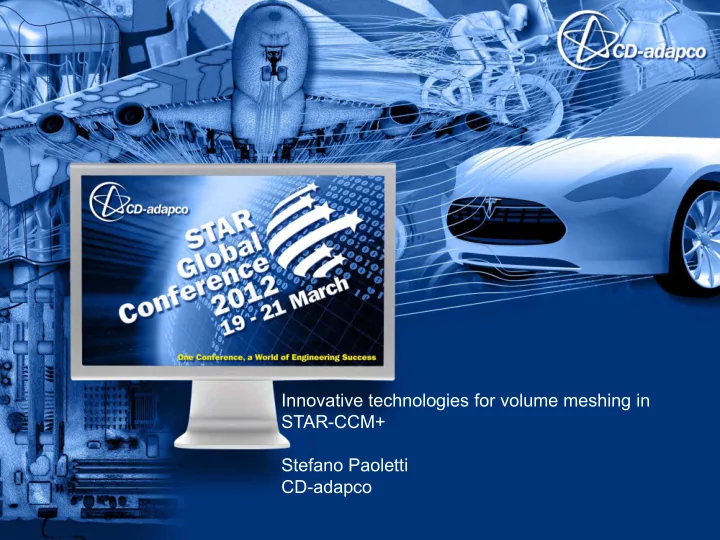

Innovative technologies for volume meshing in STAR-CCM+ Stefano Paoletti CD-adapco
Innovation in Volume Meshing CAE software is capable of analyzing several physical behaviors in geometrically complex assemblies of objects. Complex simulations are now routinely used to provide effective predictions that guide the engineering and economical choices of many industries. l The ever increasing demands of fast turn-around time and better quality spatial discretization poses a challenge to the existing approach to mesh generation.
Innovation in Volume Meshing l CD-adapco has identified the speed of mesh generation and the quality of the meshes in a large variety of geometries as key factors to help the customers in providing useful and timely physical and engineering results. l To achieve those targets, innovative meshing technologies have proved to be essential components of a continued effort to put CD-adapco customers in a competitive position.
Innovation in Volume Meshing Meshing Technologies Sharply variable section pipe meshing Minkowski Sum - Shelling for casting Parallel meshing Current approach: Domain decomposition l Future development: Parallel core algorithms l Hexahedral meshing Mostly hexahedral meshes l
Innovation in Volume Meshing Generalized Cylinder Mesher currently deals with pipes with smoothly varying sections: Developing new feature to allow sharply variable section pipe meshing:
Offsetting Meshing l Minkowski Sum l Minkowski is well known for developing the concept of spacetime in special relativity. However he also made other important contributions in the area of geometry. Hermann Minkowski (1864-1909)
Offsetting Meshing Minkowski Sum can be used as an offsetting tool We have two 2D polygonal sets A , B ∈ R2 The Minkowski sum A ⊕ B of this two sets is a set with the sum of all elements from A and all elements of B A ⊕ B= {a b ∣ a ∈ A , b ∈ B }
Offsetting Meshing Shelling is a way of constructing an extruded volume mesh. CD-adapco is working on a new mesher called Shelling Mesher for Casting Application based on the Minkowski Sum concept.
Offsetting Meshing
Offsetting Meshing
Parallel polymeshing Case: Formula 1 CAR #Cells: 23 million cells
Parallel polymeshing Domain decomposition efficiency: #Procs 16 32 48 64 Wall Time 3569 2444 2060 2260 (sec.) Wall Time diminishes up to ~50 processors
Parallel polymeshing Domain-decomposition-based parallelization vs. Core Delaunay Algorithm Parallelization Constraint Delaunay Steps: Boundary Point Insertion Boundary faces recovery Refinement Refinement is the step where most of the existing parallel methods concentrated the effort. Literature is available. Typically accounts for 50-75% of the CPU time. So Boundary Point Insertion can account up to 30-40%. Parallelization limited to the Refinement poses an upper bound for speedup: Max theoretical speedup =~ 2.5 Realistical Speedup =~ 2
Parallel polymeshing Parallel Boundary Point Insertion Use delaunay properties: Given a set of vertices in general position the mesh is unique i.e. It does not depend on the order of the insertion Vertex based domain decomposition
Parallel polymeshing Future development: independent vertex insertion + Exchange and insertion of “interfering” vertices = Load balance & same mesh as in serial
Hexahedral meshing Hexahedral meshing is considered harder that tet meshing. Why? Complex connectivity for unstructured meshes Warpage cannot be ignored on a 3D quad face Cell density tends to propagate in the whole domain BUT: Still relatively simple shape Good numerical behavior Certain physical phenomena are well discretized on hexahedra
Hexahedral Meshing Future development: Exploit Eikonal equation to describe the distance (d) from the boundary:
Hexahedral Meshing Strict relation between Advancing Layer Method, Minkowski Sum and Eikonal Equation
Hexahedral Meshing The development requires: A Quad Mesher The ALM The Eikonal equation approximated solver A (mostly) hexa layer mesher
Conclusions Several advanced meshing methodologies are under active research and development in CD-adapco. They will bring enhancements in the design cycle of new products by shortening the analysis time and by improving the quality of the simulations results. CD-adapco investment in new technologies and innovation can help our customers in keeping their competitive edge.
Recommend
More recommend